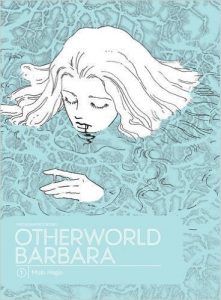By Moto Hagio. Released in Japan as “Barbara Ikai” by Shogakukan, serialized in the magazine flowers. Released in North America by Fantagraphics. Translated by Matt Thorn.
The second and final volume of Otherworld Barbara has a lot less actual Barbara in it, but that doesn’t make it any less strange. We don’t see as much of the city in Aoba and Dr. Watarai’s dreams because their own current reality is far too busy. We get a lot more revelations regarding Johannes, the guru who turns out to be responsible for a great deal of the plot. We find that Akemi, Dr. Watarai’s ex-wife, is more than simply “slightly hysterical” as I said in my last review, but borders on genuinely disturbed. And various events that seemed to be happening on Barbara, or on Mars, overlap with other events happening on Earth, so that by the end we have an emotionally rewarding but logically befuddling series of reunions. But it’s fine, because the emotional payoff is what you want here.
Despite all of the immortality research, past lives discussion, and reincarnation theories that pop up in this book, at heart it remains about Dr. Watarai’s awkward yet heartfelt efforts to bond with his son Kariya. He’s not very good at it, and Kariya is also not very good at accepting his father, and the tension between them feels very real. Kariya has several forces pulling at him here, none more so than the dream spectre of Aoba, who urges cannibalism without really going into detail about why it’s such a good idea. And then there’s the question of whether Dr. Watarai is Kariya’s real father – Akemi said he was, but she’s backtracking now, and saying “I did DNA tests that I totally didn’t fake honest” is not really the best reassurance. As it turns out, there really *is* something to the whole “eating hearts” thing, though fortunately we don’t have to go quite that far.
So much of Otherworld Barbara relies on being pulled along by the mangaka without asking too many questions, and it’s actually rather exhilarating. I’m sure that if I sat down and reread the entire series in one gulp most of it would make sense, but I am not actually sure I want to do that. There’s a certain joy involved in being just as confused as everyone else as to what’s actually going on, why Johannes is a young handsome middle-aged man but also an old guy who never leaves his room; why Kariya and Taka seem to swap bodies and lives, and what happened to Laika’s parents, which I admit caused me to say “Oh, come ON”, so that may have been one too many trips to the well. The art also serves the title well, being sensible and direct when it needs to be but gorgeous and evocative when hitting high emotional moments. The faces in particular stay with you, particularly Akemi’s 57 varieties of anger and rage.
Mostly, though, Otherworld Barbara makes me long for more works by Moto Hagio. I want to be pulled along by her as she lays out another story again. This, Heart of Thomas and A Drunken Dream just aren’t enough. What about a They Were Eleven rescue? Or A Cruel God Reigns? I bet Fantagraphics could pull off Marginal, it’s short and offbeat enough for them. Basically what I’m saying is, I think I’m addicted to this author. You should be too.


